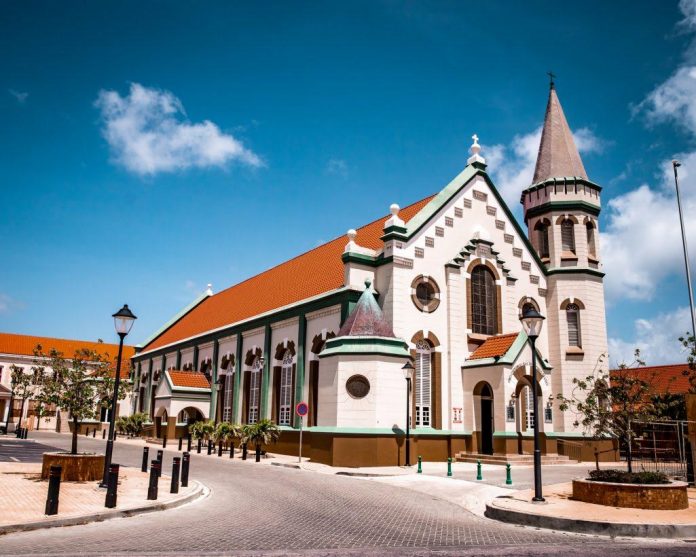Every week, Etnia Nativa writes a new episode concerning culture and heritage, focusing on various aspects of native knowledge, transcendental wisdom, and the importance of upholding cultural identity. This segment shares how the construction of the San Francisco Church in Oranjestad took place, which is now known as the Pro-Cathedral San Francisco.
It was in April of 1863 that a priest of the Capuchin order named J.A. te Riele, whose name, due to its pronunciation in the Papiamento language and deeds, resulted in “Father Terrible” built the first San Francisco Church in Oranjestad. This construction included an altar and a sacristy, which were erected in the style of cruciform church architecture. As it was a relevant event in its time, the first stone was laid by lieutenant-governor van den Bossche, who authorized the use of stones from a wall in ruins that surrounded a government plantation that was a few meters away from the chosen place for the new church construction.
Parishioners gathered while one or many helped carry stones to the construction site. With everyone’s collaboration, the construction of the church advanced rapidly. Father Terrible had intended to consecrate the church on Saint Francis Day in October, in honor of the saint, but the day of the consecration ended in a real disaster. During the consecration day, the bad weather began with intense rain accompanied by strong winds that caused the fall of one of the stone walls of the new construction.
Presumably, in order to finish the work in October, it was sped up too much. It is quite possible that the manposterie did not dry enough to soften the masonry, which could not support the heavy roof load. Only the north wall, the little tower, and the sanctuary remained standing. However, the church very soon stood erect again. In respect to the building of churches, Arubans always showed dauntless courage and fearless energy.
During the following months, Father Terrible had to travel to the Netherlands to attend to his health. During his absence, the parish priest of Santa Cruz had to officiate in the three existing churches: the church of Noord, the other in Santa Cruz, and the one of Playa (Oranjestad), so generally Noord remained without Holy Mass.
A shortage of parish priests at the time in Aruba attracted Dominican parish priests, who arrived in 1886. It was during this time in May that the Dominican order conducted the solemn consecration of the church of San Francisco.
Upon his return to the island and due to the lack of parish priests, Father Terrible wanted to initiate missionary activities among the natives of the Venezuelan coast, especially those of the Paraguaná Peninsula, affirming that many Arubans lived there for whom Papiamento was not an unknown language. The fact that it used to be one country under the Caquetio native reign kept a continuous exchange that existed from coast to coast, but the diocese of Curacao disapproved of his intentions after a few months of work on the continent.
In 1917, the original construction of the Church of San Francisco in Oranjestad was demolished, but until years later, the construction next to it, which included the old parish house, would continue in use. While the reconstruction of the Church as we currently know it came to be in 1919, which, like the Church of Santa Ana in Noord, to which we refer before and in our episode 87, was designed by the parish priest Sephanus van de Pavert O.P.
At the beginning of the 19th century, Protestant and a few Jewish families were among those who came from Curacao and abroad to settle in Oranjestad; in most cases, they were merchants who years later would get their own temples. From that time on, Protestantism had preponderance in Oranjestad.
If you are keen to explore Aruba’s deep heritage, Etnia Nativa happens to be the place of choice in its category, where you will be in the hands of a first-hand connoisseur, an owner descendant of old Aruban families, native Aruba pre-Colombian settlers, and other selected families. Etnia Nativa distinguishes itself from the rest as a hidden gem by offering a unique personal native touch that adds depth and authenticity to your destination experience with a deeper understanding of Aruba’s heritage.
A personal experience requires an appointment:
etnianativa03@gmail.com or WhatsApp (messages only) at +297 592 2702.
.

















